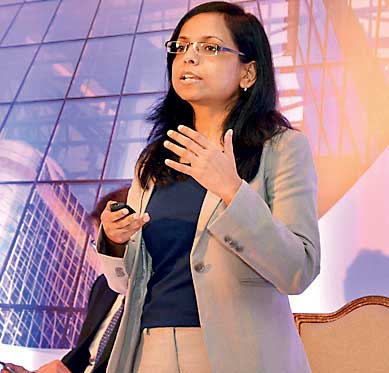-
2016 to be a far more challenging year than 2015
-
Corrective policies must be taken sooner than later
-
In vulnerable position with weak reserves, exports
-
CB expected to tighten monetary policy
By Shabiya Ali Ahlam

Sri Lanka’s economic development agenda for 2016 will see domestic challenges dwarfing global uncertainties, making it imperative for the government to deploy the correct policy measures to overcome the tides, an international economist pointed out.
Noting 2016 will remain a challenging year for the country, visiting Standard Chartered Bank South Asia Economic Research Head Anubhuti Sahay said
Sri Lanka’s economy was standing at a crucial juncture.
“The sentiment is obvious given that macroeconomic vulnerabilities have increased significantly. This effectively implies that the corrective policies will have to be taken sooner than later. Although such measures may not be people friendly, 2016 will be a far more challenging year than what 2015 was,” said Sahay while presenting her observations on the local economy at Standard Chartered Bank’s Global Research Briefing 2016 on Friday, in Colombo.
She added that corrective policy measures, if taken, would put the economy on a sustainable inflation path and stressed the need to stay cautious on the medium-term outlook.
With fiscal deficit being a primary concern and the government announcing an improved target, it was pointed out that the assumptions made by the policymakers on revenue were “overly optimistic”, making it highly unlikely for the objective to be met unless public investments were trimmed.
Given the current environment, where inflationary pressures are very strong, it is believed that the risk of public debt growing at a much faster pace remains very large. Sri Lanka, amongst its peers, has the highest public debt to gross domestic product (GDP).
Although the rating agencies have taken a lot of consolation that the public debt is coming off, Sahay warned an increase would result in a negative rating action in 2016. Worrisome is the foreign reserves standing close to just US $ 7 billion and external debt to foreign reserves ratio having deteriorated from 4 percent in 2009 to 5.6 percent in 2015 (the higher the worse).
“Starting 2016, the current deficit to GDP is closer to 3 percent. Although it is not as bad as it used to be, weak foreign reserves and low import cover leave the country in a vulnerable position,” Sahay highlighted.
Calling Sri Lanka’s GDP growth rather puzzling, she said, “The country adopted a methodology where when the first time the numbers came out, it looked all rosy and the second time it came out it looked very bleak. The improvement in GDP, which is primarily driven by consumption, is worrisome since it was boosted by public sector wage revision that came at a fiscal cost.”
Although the intention of the wage hike was to encourage private investment, it didn’t pick up as expected due to political uncertainty but resulted in a rise in private sector credit. Indicating that private sector credit remaining at the current 22 percent levels means the economy is overheating, the economist asserted it must be brought back to a much more sustainable path.
To overcome the challenges ahead, it was asserted that the government must treat fiscal consolidation as a top priority, which would require the cutting down of unnecessary exemptions and non-productive expenditure.
Sahay opined it would also require measures, which are not focused on the near term story, such as state owned enterprise (SOE) reform and expanding tax base.
“The government will have to take action to reduce imports of consumption-related food. It might hurt in the near term but possibly a better way of handling, given the enormity of the challenge at this particular period,”
she added. While not much can be done on the export side, the government is expected to increase efforts in gaining greater access to the EU, US and Indian markets with the three accounting for 70 percent of the nation’s exports.
The Central Bank is also expected to take monetary tightening measures, such as the macro prudential norms that would discourage private loans for credit to take off.
“Given the current situation, it is important to have good headline growth and ensure it is not unsustainable. Sri Lanka possesses strong fundamentals but it is imperative to accept and acknowledge the near term,” Sahay stressed.
